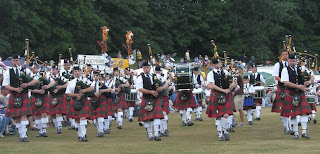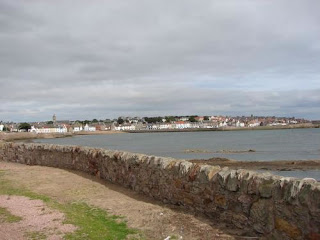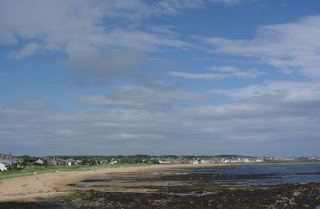Kilconquhar, Fife, Scotland, is a village in the East Neuk of Fife, Kilconquhar is situated on a knoll on the north shore of Kilconquhar Loch just north of Elie. Tour Kilconquhar,
Fife, Scotland, on an
Ancestry Tour of Scotland.
Best Scottish Tours,
Best Scottish Food,
Best Scottish Hotels,
Small Group Tours of Scotland,
Rent a Cottage in Scotland. Kilconquhar in 1846. Kilconquhar, a parish, in the district of St. Andrew's, county of Fife; containing, with the port of Earlsferry, the market-town of Colinsburgh, and the village of Barnyards, 2605 inhabitants, of whom 334 are in the village of Kilconquhar, 1½ mile (N. by W.) from Elie. The lands of Kilconquhar belonged originally to the Lindesays, of whom Walter and William de Lindesay, brothers, occupied stations of importance in the reign of David I.; the latter became the head of the family, and one of his descendants was created Earl of Crawfurd in 1398. The property is now in the possession of Sir Henry Lindesay Bethune, a descendant of the family, who, for his services in Persia, was created a baronet. John, second son of David, eighth earl of Crawfurd, obtained the estate of Balcarres, in the parish, which, together with other lands, was erected into a barony in 1592; and his son, David, who was created Lord Lindsay, of Balcarres, founded a chapel at this place, in which he was interred. David's son, Alexander, who was the first earl of Balcarres, was a firm adherent of Charles II., whom he attended while in exile at Breda, where he died a short time before the Restoration, and whence his remains were brought home, and deposited in the family chapel. The estate is now in the possession of his descendant, Colonel James Lindsay.
The parish, which derives its name from its situation at the head of a fresh-water lake, of which the Gaelic term is descriptive, is about nine miles in length, and two miles in average breadth; it is bounded on the south by the Frith of Forth, and on the west by the bay of Largo, and comprises 5400 acres, of which 2300 are arable, 2000 meadow and pasture, and 1000 woodland and plantations. The surface varies greatly in elevation. From the south, where it is mostly flat, the land rises gradually towards the north until it reaches the middle of the parish, in the hills of Reres and Kilbrachmont, which are points of a ridge extending from Kellie Law on the east, to Largo Law on the west, and having an elevation of more than 600 feet above the level of the sea. In the southern portion of the parish is the hill of Kincraig; and in the northern part is situated the hill of Dunikier Law, which has a height of 750 feet. From the summit of this hill is an extensive and varied prospect, embracing the estuaries of the Forth and the Tay, and, towards the north and west, the mountains of the counties of Perth, Angus, and Argyll. The craig of Balcarres commands a diversified view of the adjacent lands, in high cultivation, and beautifully wooded; the towns on the coast, extending from Dysart to Crail, with numerous handsome mansions surrounded by plantations; the Frith of Forth and the shipping in the harbour; the rich lands of East Lothian, the city of Edinburgh, the hills of Linlithgow, Pentland, and Lammermoor, and the German Ocean. The scenery of the parish is greatly enriched by the beautiful loch of Kilconquhar, which is about half a mile in breadth and two miles in circumference, abounding with pike and eels, and frequented by numerous swans, teal, wild-duck, and other aquatic fowl. The banks are ornamented with plantations; and from its proximity to the village, the whole forms an interesting and beautifully picturesque feature in the landscape. A small stream issuing from the lake falls into the sea at Elie. A burn, which in its course drives several mills, flows into Largo bay; and some streamlets that rise in the northern portion of the parish join the river Eden.
The soil, though generally fertile, varies considerably; in the portions near the sea, it is a light loam intermixed with sand; and in those more remote, a rich and deep loam producing abundant crops. The rotation plan of husbandry in its most improved state is practised, and the system of agriculture has been brought to great perfection; the crops are, oats, wheat, barley, beans, potatoes, and turnips, with a small quantity of flax. Much attention is paid to the rearing of cattle, which are of the Fifeshire breed, with an occasional mixture of the Teeswater; and in order to encourage improvement in this respect, the East Fife Agricultural Society hold annual meetings at Colinsburgh, for the distribution of premiums to the most successful competitors. The average number of cattle annually reared is 1500; and about 300 are fattened for the butcher. The number of horses employed in agriculture is 200, and an equal number are bred for sale; the feeding of sheep, also, has been introduced to a considerable extent, chiefly of the Cheviot breed. The plantations are oak, ash, beech, plane, and larch. Some most valuable timber is found on the lands of Balcarres, in which are many trees of majestic growth, more than two centuries old; and in that part of the estate called the Den are about 100 acres, chiefly of hard-wood of great height, and which have been planted for above half a century. The farmbuildings are generally substantial and commodious, and roofed with slate; threshing-mills are in use on the various farms, and several of them are driven by steamengines, which have been recently introduced, and appear to be on the increase. The lands have been much improved by draining; and the fences, which are usually stone dykes, are kept in good repair. The rateable annual value of Kilconquhar is £10,998.
The general coal formation extends throughout the whole of the parish; and in its various sections are found basalt, greenstone, clinkstone, trap tuffa, amygdaloid, wacke, and porphyritic claystone, sandstone, shale, ironstone, and coal. The basalt is of a greyish black colour, and extremely hard, and is found in columnar groups of great beauty, on the south-west extremity of the parish. Kincraig Hill, ascending abruptly from the beach to the height of 200 feet, abounds with all these varieties, comprehending every species of trap formation; and Balcarres Craig, which rises from a deep ravine to a similar height, and is completely detached from all the surrounding hills, displays, near its summit, a beautiful specimen of columnar formation, of a dark blue colour, exceedingly close grained and hard, and which, though possessing the properties of felspar or clinkstone rock, is frequently supposed to be basaltic. The Balcarres coalfield comprises four distinct seams, two of which are splint, and two common coal. The seams of splint coal are respectively six and two feet thick; and the seams of common coal, of which one is subdivided by an intermediate layer of marl, are about three feet in thickness. Coal is likewise found at Lathallan, Largoward, and Falfield, in the upper division of the parish, in which is also cannel coal of very superior quality. Limestone is not plentiful, but is found at Kilconquhar, Balcarres, and some other places; and large boulders of greenstone, mica-slate, and granite occur along the sea-shore. The principal seats in the parish are, Balcarres, Kilconquhar House, Charleton, Lathallan, Falfield, and Cairnie, all handsome mansions, situated in tastefully-disposed and richly-embellished demesnes. The produce of the agricultural districts is more than requisite for the supply of the population, and large quantities are consequently conveyed to the neighbouring towns, with which an easy intercourse is maintained by turnpike-roads kept in excellent repair. The village of Kilconquhar is neatly built and pleasantly situated; the inhabitants are chiefly employed in agriculture, and in weaving for the manufacturers of Dundee and Kirkcaldy. The principal articles are checks, sheetings, and dowlas, in which about 230 persons are employed, of whom 120 are females, all working at handlooms in their own dwellings; there is also a tannery, in which a few men are engaged. The parish, which formerly comprehended the whole of the parish of Elie, and the barony of St. Monan's, both separated from it in 1639, is in the presbytery of St. Andrew's and synod of Fife, and patronage of the Earl of Balcarres. The minister's stipend is about £300, with a manse, and a glebe valued at £27. 10. per annum. The church, erected in 1821, is a handsome edifice in the later English style of architecture, with a lofty tower, and is adapted for a congregation of 1030 persons. There is a chapel of ease at Largoward, built in 1835, for the accommodation of the northern part of the parish; the service is performed by a minister appointed by the presbytery. The parish also contains places of worship for members of the Relief, the Associate Synod, Independents, and Baptists. The parochial school, situated in the village of Kilconquhar, affords a liberal course of instruction; the master has a salary of £34, with £60 fees, a house and garden, and the privilege of taking boarders. There is also a school at Largoward, to the master of which the heritors pay 100 merks per annum. Under Kincraig Hill is the picturesque and romantic cavern called Macduff's Cave, in which that thane, in his flight from the usurper Macbeth, is generally supposed to have concealed himself for some time.














